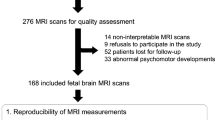Abstract
Introduction
This study aims to obtain the signal intensity changes and quantitative measurements of the subcortical brain structures of 12–22 weeks gestational age (GA).
Methods
Sixty-nine fetal specimens were selected and scanned by 7.0-T MR. The signal intensity changes of the subcortical brain structures were analyzed. The three-dimensional visualization models of the germinal matrix, caudate nucleus, lentiform nucleus, and dorsal thalamus were rebuilt with Amira 4.1, and the developmental trends between the measurements and GA were analyzed.
Results
The germinal matrix was delineated on 7.0-T MR images at 12 weeks GA, with high signals on T1-weighted images (WI). While at 16 weeks GA, the caudate nucleus, lentiform nucleus, and internal and external capsules could be distinguished. The caudate nucleus was high signal intensity on T1WI. The signal intensity of the putamen was high on T1WI during 15–17 weeks GA and was delineated as an area with uneven signal intensities. The signal intensity of the peripheral area of the putamen became higher after 18 weeks GA. The signal intensity of the globus pallidus was high on T1WI and low on T2WI after 20 weeks GA. At 18 weeks GA, the claustrum was delineated with low signals on T2WI. Measurements of the germinal matrix, caudate nucleus, lentiform nucleus, and dorsal thalamus linearly increased with the GA.
Conclusion
Development of the subcortical brain structures during 12–22 weeks GA could be displayed with 7.0-T MRI. The measurement provides significant reference beneficial to the clinical evaluation of fetal brain development.




Similar content being viewed by others
References
Malinger G, Kidron D, Schreiber L, Ben-Sira L, Hoffmann C, Lev D, Lerman-Sagie T (2007) Prenatal diagnosis of malformations of cortical development by dedicated neurosonography. Ultrasound Obstet Gynecol 29:178–191
Guibaud L (2009) Contribution of fetal cerebral MRI for diagnosis of structural anomalies. Prenat Diagn 29(4):420–433
Huisman TA, Martin E, Kubik-Huch R, Marincek B (2002) Fetal magnetic resonance imaging of the brain: technical considerations and normal brain development. Eur Radiol 12:1941–1951
Ramenghi LA, Fumagalli M, Righini A, Bassi L, Groppo M, Parazzini C, Bianchini E, Triulzi F, Mosca F (2007) Magnetic resonance imaging assessment of brain maturation in preterm neonates with punctate white matter lesions. Neuroradiology 49:161–167
Zhang Z, Liu S, Lin X, Sun B, Yu T, Geng H (2010) Development of fetal cerebral cortex: assessment of the folding conditions with post-mortem magnetic resonance imaging. Int J Dev Neurosci 28:537–543
Zhang Z, Liu S, Lin X, Teng G, Yu T, Fang F, Zang F (2011) Development of fetal brain of 20 weeks gestational age: assessment with post-mortem magnetic resonance imaging. Eur J Radiol 80:e432–e439
Zhang Z, Liu S, Lin X, Teng G, Yu T, Fang F, Zang F (2011) Development of laminar organization of the fetal cerebrum at 3.0 T and 7.0 T: a postmortem MRI study. Neuroradiology 53:177–184
Rados M, Judas M, Kostović I (2006) In vitro MRI of brain development. Eur J Radiol 57:187–198
Whitby EH, Paley MN, Cohen M, Griffiths PD (2006) Post-mortem fetal MRI: what do we learn from it? Eur J Radiol 57:250–255
Kinoshita Y, Okudera T, Tsuru E, Yokota A (2001) Volumetric analysis of the germinal matrix and lateral ventricles performed using MR images of postmortem fetuses. Am J Neuroradiol 22:382–388
Guihard-Costa AM, Ménez F, Delezoide AL (2002) Organ weights in human fetuses after formalin fixation: standards by gestational age and body weight. Pediatr Dev Pathol 5:559–578
Huang H, Xue R, Zhang J, Ren T, Richards LJ, Yarowsky P, Miller MI, Mori S (2009) Anatomical characterization of human fetal brain development with diffusion tensor magnetic resonance imaging. J Neurosci 29:4263–4273
Prayer D, Kasprian G, Krampl E, Ulm B, Witzani L, Prayer L, Brugger PC (2006) MRI of normal fetal brain development. Eur J Radiol 57:199–216
Jakovcevski I, Zecevic N (2005) Sequence of oligodendrocyte development in the human fetal telencephalon. Glia 49:480–491
Taoka T, Aida N, Ochi T, Takahashi Y, Akashi T, Miyasaka T, Iwamura A, Sakamoto M, Kichikawa K (2011) Transient hyperintensity in the subthalamic nucleus and globus pallidus of newborns on T1-weighted images. Am J Neuroradiol 32:1130–1137
Counsell SJ, Maalouf EF, Fletcher AM, Duggan P, Battin M, Lewis HJ, Herlihy AH, Edwards AD, Bydder GM, Rutherford MA (2002) MR imaging assessment of myelination in the very preterm brain. Am J Neuroradiol 23:872–881
De Vita E, Bainbridge A, Cheong JL, Hagmann C, Lombard R, Chong WK, Wyatt JS, Cady EB, Ordidge RJ, Robertson NJ (2006) Magnetic resonance imaging of neonatal encephalopathy at 4.7 tesla: initial experiences. Pediatrics 118:e1812–e1821
Lin X, Zhang Z, Teng G, Meng H, Yu T, Hou Z, Fang F, Zang F, Liu S (2011) Measurements using 7.0 T post-mortem magnetic resonance imaging of the scalar dimensions of the fetal brain between 12 and 20 weeks gestational age. Int J Dev Neurosci 29:885–889
Acknowledgments
This work was supported by the National Natural Science Foundation of China (no. 31071050), Promotive Research Fund for Excellent Young and Middle-Aged Scientists of Shandong Province (BS2010YY042). The authors thank Bingzhi Liu, Qingcai Zhou, Shuhui Hong, Jianfen Jiao, and Xinting Gai for the postmortem fetus collection.
Conflict of interest
We declare that we have no conflict of interest.
Author information
Authors and Affiliations
Corresponding author
Rights and permissions
About this article
Cite this article
Meng, H., Zhang, Z., Geng, H. et al. Development of the subcortical brain structures in the second trimester: assessment with 7.0-T MRI. Neuroradiology 54, 1153–1159 (2012). https://doi.org/10.1007/s00234-012-1069-x
Received:
Accepted:
Published:
Issue Date:
DOI: https://doi.org/10.1007/s00234-012-1069-x




